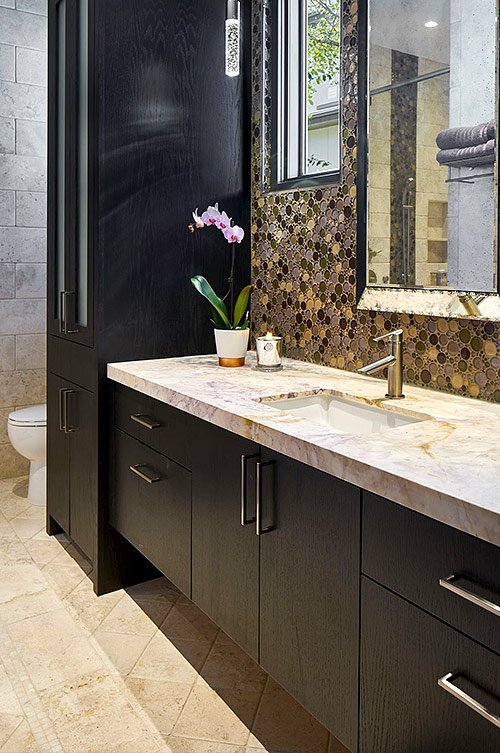TRAVERTINE
Travertine is as a variety of limestone with linear striations and prized for their earthy tones. A once popular material in the “Tuscan-rustic” look, Travertines are slowly working their way back into the contemporary look with their ability to “ground” a highly contemporary design.
WHAT YOU SHOULD KNOW ABOUT TRAVERTINE
Travertine is a type of limestone that is created from very high heat and pressure, resulting in an extremely durable stone that can actually last longer than many other materials.
Travertine is the terrestrial (land) formed version of limestone, as opposed to the marine based formations of many other limestone varieties. Since these stones are some of the softer varieties of natural stone materials, they have long been a popular choice for intricately carved features and moldings, as well as statuary. Travertine, like marble, is of a calcium carbonate base, and as such, is vulnerable to alteration by exposure to mild acids. A wide variety of stones are included in this group, and absorption varies from slight (<1%) to high (>10%). The combination of acid sensitivity and absorption limit the number of varieties that are suitable for countertop applications, and the user of Travertine countertops should be well educated in its properties to accurately anticipate its behavior in service.
FREQUENTLY ASKED QUESTIONS
MATERIAL CONSIDERATIONS
ABRASION RESISTANCE
Moderate
On the Moh’s Scale of Relative Hardness, travertine ranks between 4 and 5. Daily impacts will not cause damage to travertine. Even the uncommon heavy impact should not cause damage to it. Chipping, scratching, and cracking are rarities with this type of material.
ABSORPTION/STAINING
Moderate
Non-acidic spills will not harm travertine, regardless of whether the spill is cleaned up right away or left to sit. Honed and tumbled travertine are the two types most likely to pick up stains and thus require sealing. Polished travertine is highly stain-resistant so you probably won’t need to seal it.
ACID SENSITIVITY
High
Acidic substances like wine or juice can easily etch travertine’s finish. This is because it’s a natural stone formed from calcium carbonate which can break down over time when exposed to acidic substances like vinegar, wine and any citric acids. Acidic materials should be wiped up immediately!
HEAT RESISTANCE
High
Because of the way travertine is formed, it is particularly resistant to heat and pressure, making it an ideal building material for both indoor and outdoor projects such as fireplaces, bathroom floors and showers, and around swimming pools.
What Our Customers Say
Delta Granite and Marble did all of the counter tops in my house, which included two bathrooms, kitchen, and a bar area. The kitchen also had a large island so it was a significant amount of product, about $11,000 worth of counter tops. We really enjoyed working with the sales rep, Rick: he was very willing to revise pricing, change products and find us the best value. The thing I was most impressed with was the measurements. They laser measured everything and everything fit perfectly, David the install guy was great and we were absolutely happy with the end result. They are a very professional organization. In fact, I will be giving them business again on a commercial property I am working on
Everyone in the office and the people who installed the vanity top was very, very professional. Would recommend highly to anyone. Everything was just great! We had a bad experience at a competitor and when we came to Delta it was a 180 degree turn in terms of experience. We wish we had started with Delta, but now we know!
Delta Granite and Marble is absolutely excellent. We recently had an issue with our contractor, but they were able to pick up the job right where they left off. The guys who did the installation were very nice, friendly, and professional. They were also great with communication. Any time we called they got back to us immediately. I’d highly recommend them!


